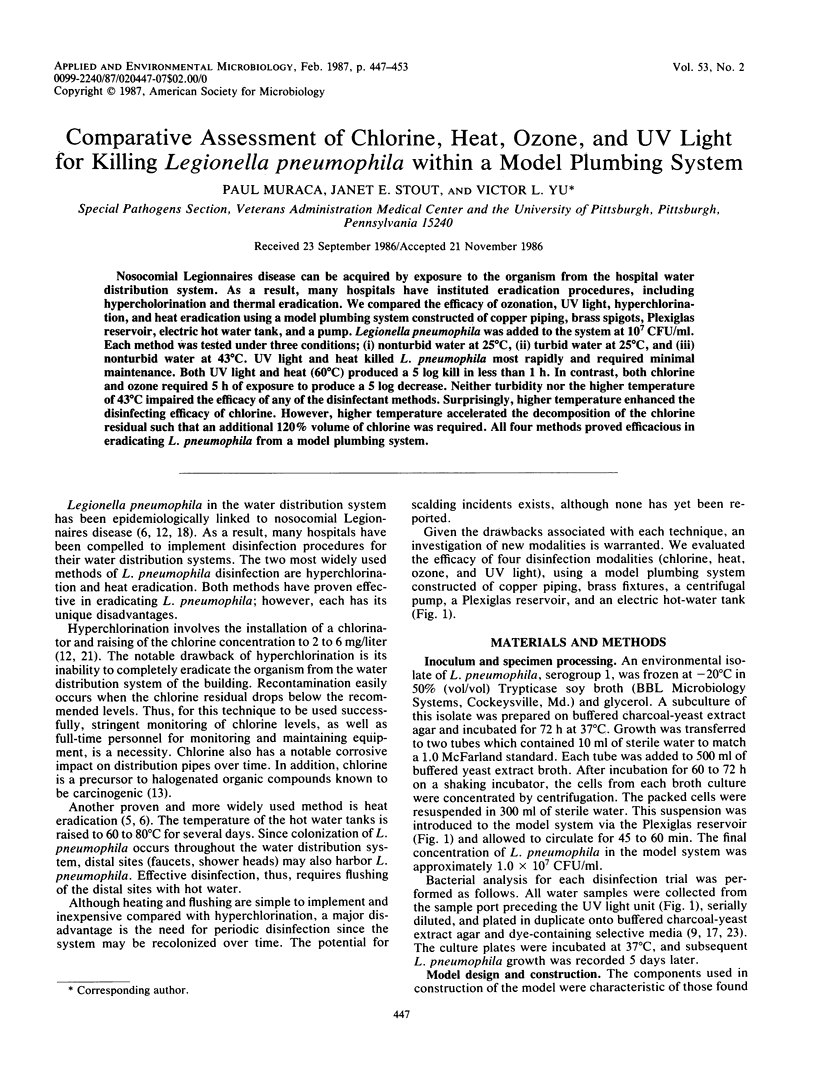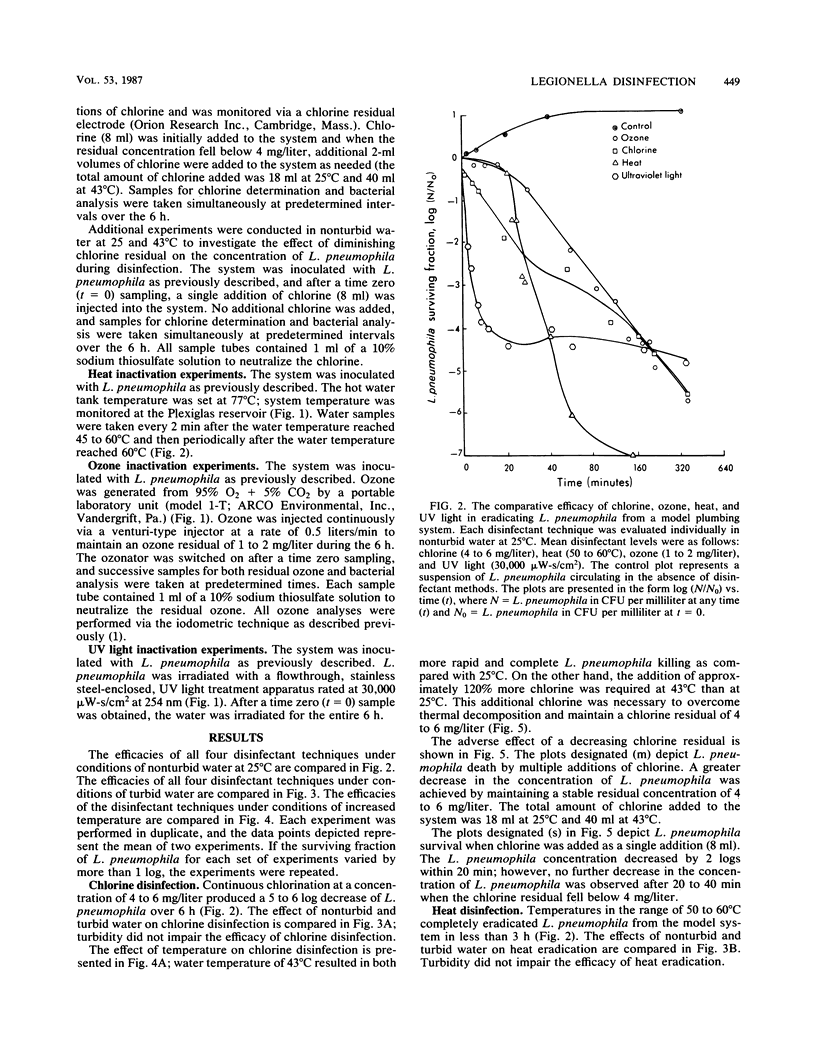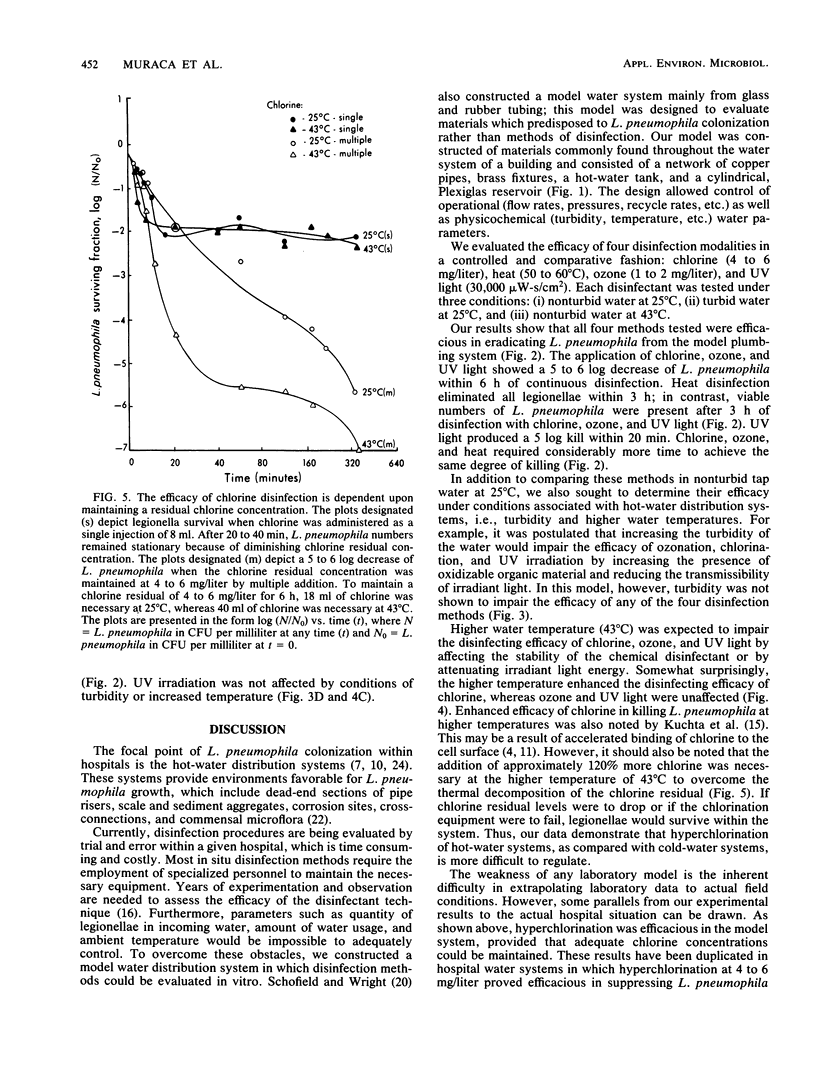Abstract
Nosocomial Legionnaires disease can be acquired by exposure to the organism from the hospital water distribution system. As a result, many hospitals have instituted eradication procedures, including hypercholorination and thermal eradication. We compared the efficacy of ozonation, UV light, hyperchlorination, and heat eradication using a model plumbing system constructed of copper piping, brass spigots, Plexiglas reservoir, electric hot water tank, and a pump. Legionella pneumophila was added to the system at 10(7) CFU/ml. Each method was tested under three conditions; (i) nonturbid water at 25 degrees C, (ii) turbid water at 25 degrees C, and (iii) nonturbid water at 43 degrees C. UV light and heat killed L. pneumophila most rapidly and required minimal maintenance. Both UV light and heat (60 degrees C) produced a 5 log kill in less than 1 h. In contrast, both chlorine and ozone required 5 h of exposure to produce a 5 log decrease. Neither turbidity nor the higher temperature of 43 degrees C impaired the efficacy of any of the disinfectant methods. Surprisingly, higher temperature enhanced the disinfecting efficacy of chlorine. However, higher temperature accelerated the decomposition of the chlorine residual such that an additional 120% volume of chlorine was required. All four methods proved efficacious in eradicating L. pneumophila from a model plumbing system.
Full text
PDF






Images in this article
Selected References
These references are in PubMed. This may not be the complete list of references from this article.
- Antopol S. C., Ellner P. D. Susceptibility of Legionella pneumophila to ultraviolet radiation. Appl Environ Microbiol. 1979 Aug;38(2):347–348. doi: 10.1128/aem.38.2.347-348.1979. [DOI] [PMC free article] [PubMed] [Google Scholar]
- Best M., Goetz A., Yu V. L. Heat eradication measures for control of nosocomial Legionnaires' disease. Implementation, education, and cost analysis. Am J Infect Control. 1984 Feb;12(1):26–30. doi: 10.1016/0196-6553(84)90069-5. [DOI] [PubMed] [Google Scholar]
- Best M., Yu V. L., Stout J., Goetz A., Muder R. R., Taylor F. Legionellaceae in the hospital water-supply. Epidemiological link with disease and evaluation of a method for control of nosocomial legionnaires' disease and Pittsburgh pneumonia. Lancet. 1983 Aug 6;2(8345):307–310. doi: 10.1016/s0140-6736(83)90290-8. [DOI] [PubMed] [Google Scholar]
- Dennis P. J., Taylor J. A., Fitzgeorge R. B., Bartlett C. L., Barrow G. I. Legionella pneumophila in water plumbing systems. Lancet. 1982 Apr 24;1(8278):949–951. doi: 10.1016/s0140-6736(82)91944-4. [DOI] [PubMed] [Google Scholar]
- Edelstein P. H., Whittaker R. E., Kreiling R. L., Howell C. L. Efficacy of ozone in eradication of Legionella pneumophila from hospital plumbing fixtures. Appl Environ Microbiol. 1982 Dec;44(6):1330–1333. doi: 10.1128/aem.44.6.1330-1333.1982. [DOI] [PMC free article] [PubMed] [Google Scholar]
- Feeley J. C., Gibson R. J., Gorman G. W., Langford N. C., Rasheed J. K., Mackel D. C., Baine W. B. Charcoal-yeast extract agar: primary isolation medium for Legionella pneumophila. J Clin Microbiol. 1979 Oct;10(4):437–441. doi: 10.1128/jcm.10.4.437-441.1979. [DOI] [PMC free article] [PubMed] [Google Scholar]
- Johnson J. T., Yu V. L., Best M. G., Vickers R. M., Goetz A., Wagner R., Wicker H., Woo A. Nosocomial legionellosis in surgical patients with head-and-neck cancer: implications for epidemiological reservoir and mode of transmission. Lancet. 1985 Aug 10;2(8450):298–300. doi: 10.1016/s0140-6736(85)90349-6. [DOI] [PubMed] [Google Scholar]
- Knudson G. B. Photoreactivation of UV-irradiated Legionella pneumophila and other Legionella species. Appl Environ Microbiol. 1985 Apr;49(4):975–980. doi: 10.1128/aem.49.4.975-980.1985. [DOI] [PMC free article] [PubMed] [Google Scholar]
- Kuchta J. M., States S. J., McNamara A. M., Wadowsky R. M., Yee R. B. Susceptibility of Legionella pneumophila to chlorine in tap water. Appl Environ Microbiol. 1983 Nov;46(5):1134–1139. doi: 10.1128/aem.46.5.1134-1139.1983. [DOI] [PMC free article] [PubMed] [Google Scholar]
- Muder R. R., Yu V. L., Woo A. H. Mode of transmission of Legionella pneumophila. A critical review. Arch Intern Med. 1986 Aug;146(8):1607–1612. [PubMed] [Google Scholar]
- Pasculle A. W., Feeley J. C., Gibson R. J., Cordes L. G., Myerowitz R. L., Patton C. M., Gorman G. W., Carmack C. L., Ezzell J. W., Dowling J. N. Pittsburgh pneumonia agent: direct isolation from human lung tissue. J Infect Dis. 1980 Jun;141(6):727–732. doi: 10.1093/infdis/141.6.727. [DOI] [PubMed] [Google Scholar]
- Plouffe J. F., Para M. F., Maher W. E., Hackman B., Webster L. Subtypes of Legionella pneumophila serogroup 1 associated with different attack rates. Lancet. 1983 Sep 17;2(8351):649–650. doi: 10.1016/s0140-6736(83)92531-x. [DOI] [PubMed] [Google Scholar]
- Plouffe J. F., Webster L. R., Hackman B. Relationship between colonization of hospital building with Legionella pneumophila and hot water temperatures. Appl Environ Microbiol. 1983 Sep;46(3):769–770. doi: 10.1128/aem.46.3.769-770.1983. [DOI] [PMC free article] [PubMed] [Google Scholar]
- Schofield G. M., Wright A. E. Survival of Legionella pneumophila in a model hot water distribution system. J Gen Microbiol. 1984 Jul;130(7):1751–1756. doi: 10.1099/00221287-130-7-1751. [DOI] [PubMed] [Google Scholar]
- Shands K. N., Ho J. L., Meyer R. D., Gorman G. W., Edelstein P. H., Mallison G. F., Finegold S. M., Fraser D. W. Potable water as a source of Legionnaires' disease. JAMA. 1985 Mar 8;253(10):1412–1416. [PubMed] [Google Scholar]
- Stout J. E., Yu V. L., Best M. G. Ecology of Legionella pneumophila within water distribution systems. Appl Environ Microbiol. 1985 Jan;49(1):221–228. doi: 10.1128/aem.49.1.221-228.1985. [DOI] [PMC free article] [PubMed] [Google Scholar]
- Stout J., Yu V. L., Vickers R. M., Shonnard J. Potable water supply as the hospital reservoir for Pittsburgh pneumonia agent. Lancet. 1982 Feb 27;1(8270):471–472. doi: 10.1016/s0140-6736(82)91449-0. [DOI] [PubMed] [Google Scholar]
- Stout J., Yu V. L., Vickers R. M., Zuravleff J., Best M., Brown A., Yee R. B., Wadowsky R. Ubiquitousness of Legionella pneumophila in the water supply of a hospital with endemic Legionnaires' disease. N Engl J Med. 1982 Feb 25;306(8):466–468. doi: 10.1056/NEJM198202253060807. [DOI] [PubMed] [Google Scholar]



